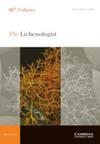对卡莫尼卡山谷岩石艺术中地衣和其他岩石生物的生态调查(联合国教科文组织世界遗产名录第94号)提出了预防性保护策略
IF 1.4
4区 生物学
Q4 MYCOLOGY
引用次数: 1
摘要
环境控制策略通常用于限制威胁室内文化遗产的生物退化问题,而它们仍然很少用于保护室外石头遗产表面,包括岩石艺术。在这项研究中,我们评估了影响Naquane岩石雕刻国家公园(UNESCO WHS n. 94, Italy)岩生生物群落多样性和丰度的环境因素。该调查考虑了在过去3年(3YC)或12年(12YC)或40多年前(NRC)被清洗过的23块岩石。以蓝藻为主的生物膜和地衣(37个类群)是最广泛和最丰富的岩生生物成分,分别分布在3YC-12YC和NRC岩石上。在后者上,观察到旱生和中湿生地衣群落的更替。在3YC-12YC岩石上,如果存在地衣定植,则仅限于硝化物种,包括来自周围树木的常见附生植物和少数中湿生物种,并普遍采用无性繁殖策略。包括环境参数在内的多变量分析(典型对应分析)表明,树木覆盖和岩石上游裸露或植被的存在,可能延长了水分并通过水运提供养分,是3YC-12YC表面微生物和地衣再定殖的主要因素。在此基础上,进行了一项预防性保护实验,包括对一个强再聚落的3YC表面进行新的清理,并建立一个小墙来保护部分岩石免受长时间水通量的影响。在这项新的清洁干预措施实施40个月后,对岩石表面进行的荧光和比色监测显示,仅在未受保护的地区重新定殖,表明在室外环境中采取预防性保护战略的潜力。本文章由计算机程序翻译,如有差异,请以英文原文为准。
An ecological investigation on lichens and other lithobionts colonizing rock art in Valle Camonica (UNESCO WHS n. 94) addresses preventive conservation strategies
Abstract Environmental control strategies are commonly practised to limit biodeterioration issues threatening indoor cultural heritage objects, while they are still poorly exploited for the conservation of outdoor stone heritage surfaces, including rock art. In this study, we evaluated the environmental factors driving the diversity and abundance of lithobiontic communities in the Rock Engravings National Park of Naquane (UNESCO WHS n. 94, Italy). The survey considered 23 rocks that had been cleaned in the last three (3YC) or twelve (12YC) years or more than 40 years ago (NRC). A cyanobacteria-dominated biofilm and lichens (37 taxa) were the most widespread and abundant lithobiontic components, prevailing on 3YC–12YC and NRC rocks, respectively. On the latter, a turnover of xerophytic and meso-hygrophytic lichen communities was observed. On 3YC–12YC rocks lichen colonization, if present, was limited to nitrophytic species, including common epiphytes from surrounding trees and a small number of meso-hygrophytic species, with a prevalence of asexual reproductive strategies. Multivariate analyses including environmental parameters (canonical correspondence analyses) indicated that tree cover and the presence of bare or vegetated ground upstream of the rocks, probably prolonging wetness and providing nutrients by water transport, are the factors mostly related to the microbial and lichen recolonization of 3YC–12YC surfaces. On this basis, an experiment on preventive conservation was conducted, consisting of a new cleaning of a strongly recolonized 3YC surface combined with the building of a small wall to protect part of the rock from prolonged water fluxes. The fluorimetric and colorimetric monitoring of the rock surface, carried out 40 months after this new cleaning intervention, displayed recolonization on the unprotected area only, indicating the potential of preventive conservation strategies in outdoor environments.
求助全文
通过发布文献求助,成功后即可免费获取论文全文。
去求助
来源期刊

Lichenologist
生物-真菌学
CiteScore
2.90
自引率
14.30%
发文量
23
审稿时长
6.0 months
期刊介绍:
The Lichenologist is the premier scientific journal devoted exclusively to the study of lichens worldwide. As the leading forum for the dissemination of new concepts and topical reviews, The Lichenologist reaches more scientists concerned with the study of lichens and lichen symbionts than any other single journal. All aspects of lichenology are considered including systematics and phylogenetics; molecular biology; ultrastructure, anatomy and morphology; secondary chemistry, effects of pollutants and use as bioindicators; biogeography. In addition to standard length research papers, the journal also publishes Short Communications and Book Reviews. A monthly issue may occasionally be devoted to papers deriving from a symposium.
 求助内容:
求助内容: 应助结果提醒方式:
应助结果提醒方式:


